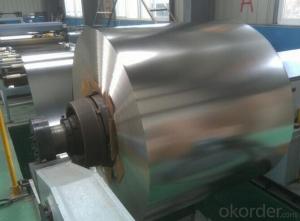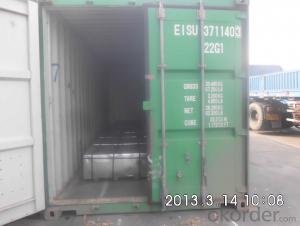Prime Good Quality Tinplate For Metal Can
- Loading Port:
- China Main Port
- Payment Terms:
- TT OR LC
- Min Order Qty:
- -
- Supply Capability:
- -
OKorder Service Pledge
OKorder Financial Service
You Might Also Like
We have been producing tinplate material professionally and providing related service for decades years. Now we have been exporting our material to the world. Please kindly contact us to meet your needs for ETP materail.
Below is the specification we currently do:
1. Standard: GB/T 2520-2000, JIS G3303-2002 and DIN EN 10203-1991
2. Raw material: MR, SPCC
3.Thickness: 0.18 to 0.50mm
4. Width: 260 to 980mm
5. Coil diameter: ID 420mm or 508mm
6. Temper grade: T2, T3 and T4
7. Tin coating: ordinary 2.8 or 2.8g and 5.6g or 5.6g, can produce according to customer's requests
8. Applications: paint, chemical and other usage can make battery, electric cable and other industries
9. Package: anti-rust paper, corner protected. Sheets or coils according customer's request.
Standard for Temper:
code | Chinese Stardard | Japaness Standard | American Standard | European Standard | International Standard |
| GB/T 2520-2000 | JIS G3303-2002 | ASTM A623M-2002 | DIN EN 10203-1991 | ISO 11949-1995 |
T-2 | TH52+SE | T-2 | T-2(53) | T52 | TH52+SE |
T-2.5 | TH55+SE | T-2.5 |
|
| TH55+SE |
T-3 | TH57+SE | T-3 | T-3(T57) | T57 | TH57+SE |
T-3.5 |
|
|
|
|
|
T-4 | TH61+SE | T-4 | T-4(T61) | T61 | TH61+SE |
Surface of tinplate:
Marks | Surface state | Characteristics |
B | Bright rough | Glazed surface obtained after melting treatment of electrotinned smooth raw material strip featuring certain oriented rubstone figure. |
R | Stone rough | Glazed surface obtained after melting treatment of electrotinned raw material strip featuring certain oriented rubstone figure. |
S | Silver rough | Glazed surface obtained after melting treatment of electrotinned raw material strip with rough matt surface. |
- Q: How is tinplate coated?
- Tinplate is coated through a process called electrolytic tinning. In this process, a thin layer of tin is electroplated onto the surface of steel sheets or strips. The steel is immersed in an electrolyte bath containing tin salts, and an electric current is passed through the bath. This causes the tin to deposit onto the steel surface, creating a protective coating that prevents corrosion and enhances the appearance of the tinplate.
- Q: What are the different types of tinplate containers available?
- There are several different types of tinplate containers available, including cans, tins, boxes, and drums. These containers can come in various shapes and sizes, and they are often used for packaging food, beverages, chemicals, and other products. Tinplate containers are known for their durability and ability to protect the contents from external factors such as light, air, and moisture.
- Q: How is tinplate coated with metallic coatings?
- Tinplate is coated with metallic coatings through a process called electroplating. In this process, a tinplate sheet is immersed in a bath containing the desired metal ions, such as tin or chromium. An electric current is then passed through the bath, causing the metal ions to bond with the surface of the tinplate, resulting in a uniform metallic coating. This coating enhances the tinplate's corrosion resistance and provides a decorative finish.
- Q: What are the welding methods used for tinplate?
- The welding methods commonly used for tinplate include spot welding, seam welding, and resistance welding.
- Q: How does tinplate packaging contribute to product shelf life?
- Tinplate packaging contributes to product shelf life by providing a protective barrier against moisture, light, and oxygen, which helps to prevent spoilage, oxidation, and degradation of the product. This type of packaging also enhances product stability, preserves freshness, and extends the overall shelf life, ensuring that the product maintains its quality and integrity for a longer period of time.
- Q: What is tinplate?
- Tinplate is a thin steel sheet coated with a layer of tin, which provides corrosion resistance and enhances its aesthetic appeal.
- Q: Can tinplate be used for construction applications?
- Yes, tinplate can be used for construction applications. It is often utilized for roofing, siding, ceilings, and other structural components due to its durability, corrosion resistance, and lightweight properties.
- Q: What are the main trends in tinplate packaging design?
- Some of the main trends in tinplate packaging design include minimalism and simplicity, eco-friendly and sustainable packaging solutions, innovative and unique shapes and designs, vintage and retro-inspired aesthetics, and the use of vibrant and eye-catching colors to attract consumers. Additionally, there is a growing focus on functional and practical packaging designs that enhance the user experience and provide convenience.
- Q: How does tinplate perform in terms of magnetic properties?
- Tinplate is not inherently magnetic, as it is made by coating a thin layer of tin onto steel. However, the steel base of tinplate can retain its magnetic properties.
- Q: How does tinplate perform in terms of light blocking properties?
- Tinplate is known to provide excellent light blocking properties due to its opaque and reflective nature, making it an effective choice for packaging materials to prevent light exposure and preserve the quality of light-sensitive products.
Send your message to us
Prime Good Quality Tinplate For Metal Can
- Loading Port:
- China Main Port
- Payment Terms:
- TT OR LC
- Min Order Qty:
- -
- Supply Capability:
- -
OKorder Service Pledge
OKorder Financial Service
Similar products
Hot products
Hot Searches
Related keywords



























